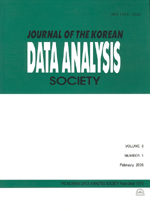일반화 이산형 분포를 이용한 학습곡선의 모형화
Statistical Modeling of Learning-curve Effects based on Generalized Discrete Distributions
- 한국자료분석학회
- Journal of The Korean Data Analysis Society (JKDAS)
- Vol.17 No.1
-
2015.02127 - 140 (14 pages)
- 21

학습현상은 2차 세계대전 이전에 항공 산업에서 항공기의 누적생산량 증가에 따라 항공기 당 직접노동시간이 일정한 비율로 감소한다는 것이 Wright(1936)에 의해 최초로 밝혀졌다. 일반적으로 어떤 작업을 반복적으로 수행하는 경우 작업자의 숙련도 향상과 작업 절차 조정 및 사용 기계의 작업능력 향상이 발생하는데 이러한 현상을 학습곡선효과(learning-curve effects)라고 한다. 본 연구에서는 개수형 변수가 반복적으로 관찰되는 경우 학습곡선 효과에 의해 발생건수가 특정한 형태로 줄어들고 변동성 역시 변화하는 자료를 적합하기 위해 일반화 포아송분포와 일반화 음이항분포를 고려한 학습곡선을 모형화 하고자 한다. 모의실험을 통해 본 논문에서 제안한 모형을 기존의 이산형 분포들(포아송분포, 음이항분포)과 비교하였다. 또한 실증연구를 통해 제안한 모형을 오렌지주스 캔 자료(Montgomery, 1991)에 적합하였다.
The learning curve was first researched by Wright (1936), where direct work hour per aircraft decreased as a cumulative output per airplane increased in the aviation industry before World War 2. When a worker repeatedly performs a certain job, his production hour decreases. This phenomenon called ‘learning-curve effects’ results from the improvement of skill level of a worker and that of capacity for work by using machine. In this study, we propose modelling of learning-curve effects based on generalized Poisson distribution and generalize negative-binomial distribution in order to estimate both average number of events of interest and its variability. This paper examines features of our proposed models via simulation studies and real application.
1. 서론
2. 일반화 이산형 분포와 모형구축
3. 모의실험
4. 실증연구
5. 결론
References
(0)
(0)